Fact Sheet 2010–3079
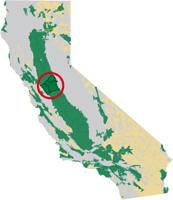
U.S. Geological Survey and the California State Water Resources Control BoardGroundwater Quality in the Northern San Joaquin Valley, CaliforniaBy George L. Bennett V and Kenneth BelitzGroundwater provides more than 40 percent of California’s drinking water. To protect this vital resource, the State of California created the Groundwater Ambient Monitoring and Assessment (GAMA) Program. The Priority Basin Project of the GAMA Program provides a comprehensive assessment of the State’s groundwater quality and increases public access to groundwater-quality information. The Northern San Joaquin constitutes one of the study units being evaluated. |
The Northern San Joaquin Study UnitThe Northern San Joaquin (NSJ) study unit is located in California’s San Joaquin Valley and includes the Cosumnes, Eastern San Joaquin, and Tracy groundwater subbasins (California Department of Water Resources, 2003). The 2,079-square-mile study unit was divided into four study areas: Cosumnes, Eastern San Joaquin, Tracy, and Uplands (Quaternary-Pleistocene semiconsolidated deposits). The NSJ study unit has hot and dry summers and cool, moist, winters. Average annual rainfall ranges from 11 to 15 inches. Most rivers and streams flowing across the study unit drain into the San Joaquin River, which flows northwestward into the Sacramento-San Joaquin Delta and San Francisco Bay estuary. Aquifers in the study unit consist of interlayered lenses of gravel, sand, silt, and clay deposited by rivers draining the Sierra Nevada to the east but also from the Coast Ranges to the west. The primary aquifers in the NSJ study unit are defined as those parts of the aquifers corresponding to the perforated intervals of the wells listed in the California Department of Public Health (CDPH) database. The public-supply wells monitored by CDPH typically are completed in the primary aquifers to depths of 250–500 feet below land surface (bls). The wells contain solid casing reaching from the land surface to about 100 to 250 feet bls and are perforated below the solid casing to allow water into the well. Water quality in the primary aquifers may differ from the water in shallow and deep parts of the aquifer system. 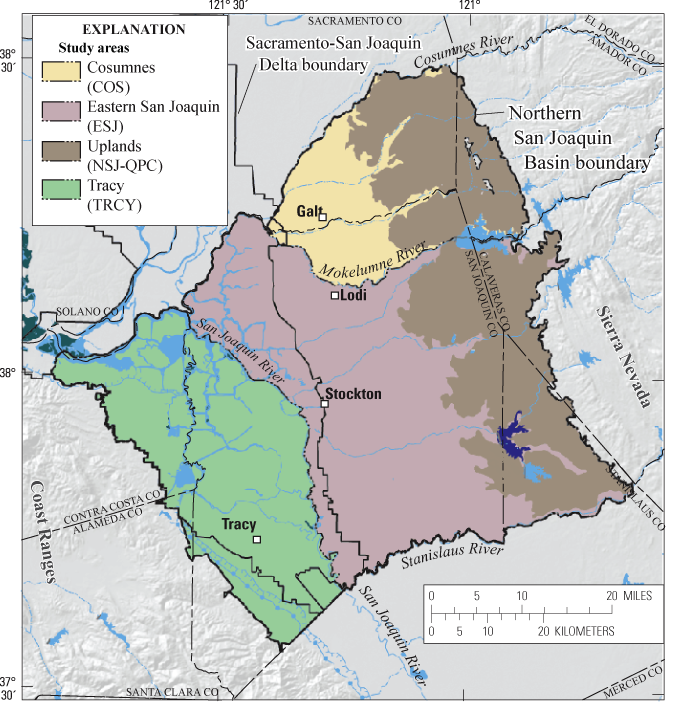
Land use in the study unit is about 57 percent (%) agricultural, 36% natural (primarily grassland), and 7% urban. The largest urban area in the study unit is the City of Stockton, with a population of 287,578 (U.S. Census Bureau, 2009 estimate). Recharge to the groundwater flow system primarily is from percolation of irrigation return water, precipitation, seepage from reservoirs and rivers, and urban runoff (Northeastern San Joaquin County Groundwater Banking Authority, 2004). The primary sources of groundwater discharge are pumping for irrigation and municipal water supply, evaporation from areas with a shallow depth to water, and discharge to streams. Overview of Water Quality GAMA’s Priority Basin Project evaluates the quality of untreated groundwater; however, for context, benchmarks established for drinking-water quality are used for comparison. Benchmarks, and definitions of high, moderate, and low concentrations, are discussed in the inset box on page 3. Many inorganic constituents occur naturally in groundwater. The concentrations of the inorganic constituents can be affected by natural processes as well as by human activity. In the NSJ study unit, one or more inorganic constituents were detected at high concentrations in about 13% of the primary aquifers and at moderate concentrations in about 29%. Organic constituents are present in products used in the home, business, industry, and agriculture. Organic constituents can enter the environment through normal usage, spills, or improper disposal. In the NSJ study unit, one or more organic constituents were present at high concentrations in about 3% of the primary aquifers and at moderate concentrations in about 7%. RESULTS: Groundwater Quality in the Northern San Joaquin Study Unit Inorganic Constituents with Human-Health BenchmarksTrace and minor elements are naturally present in the minerals in rocks and soils, and in the water that comes into contact with those materials. In the NSJ study unit, trace elements were detected at high concentrations in about 13% of the primary aquifers, and in moderate concentrations in about 25%. Arsenic and boron were the trace elements that most frequently occurred at high concentrations. Antimony, fluoride, lead, mercury, and vanadium also were detected at high concentrations, but in less than (<) 1% of the primary aquifers. Radioactivity is the release of energy or energetic particles during structural changes in the nucleus of an atom. Most of the radioactivity in groundwater comes from decay of naturally occurring isotopes of uranium and thorium in minerals in the sediments of the aquifers. In the NSJ study unit, radioactive constituents occurred at high levels in about 2% of the primary aquifers and were either low or not detected in the remaining 98% of the primary aquifers. Nutrients, such as nitrate and nitrite, are naturally present at low concentrations in groundwater. High and moderate concentrations generally occur as a result of human activities. Common sources of nutrients include fertilizer applied to crops and landscaping, seepage from septic systems, and human and animal waste. In the NSJ study unit, nutrients were present at high and moderate concentrations in about 2 and 9% of the primary aquifers, respectively. Inorganic Constituents with Non-Health Benchmarks(Not included in water-quality overview charts)Some constituents affect the aesthetic properties of water, such as taste, color, and odor, or may create nuisance problems, such as staining and scaling. The State of California has a recommended and an upper limit for total dissolved solids (TDS). All water naturally contains TDS as a result of the weathering and dissolution of minerals in soils. Anoxic conditions in groundwater (very low amounts of dissolved oxygen) may result in the release of manganese and iron from minerals into groundwater. In the NSJ study unit, TDS was present at high concentrations (greater than the upper limit) in about 6% of the primary aquifers, and at moderate concentrations in about 16%. Chloride and sulfate occurred at high concentrations in the primary aquifers and contributed to high concentrations of TDS. Manganese with or without iron was present at high or moderate concentrations in about 34 and 5% of the primary aquifers, respectively. Perchlorate(Not included in water-quality overview charts) Perchlorate is an inorganic constituent that has been regulated in California drinking water since 2007. It is an ingredient in rocket fuel, fireworks, safety flares and other products, may be present in some fertilizers, and also occurs naturally at low concentrations in groundwater. In the NSJ study unit, perchlorate was not detected at high concentrations but was detected at moderate concentrations in about 3% of the primary aquifers. 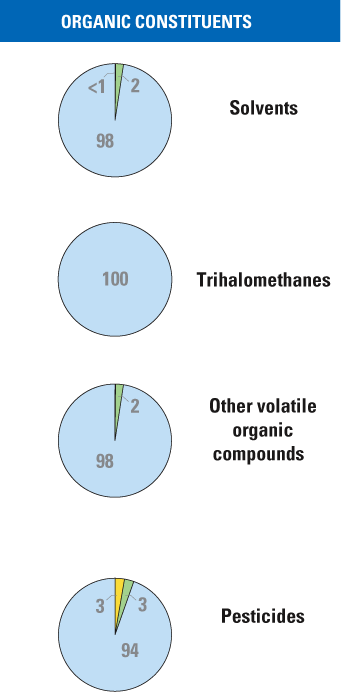 Organic ConstituentsThe Priority Basin Project uses laboratory methods that can detect low concentrations of volatile organic compounds (VOCs) and pesticides far below human-health benchmarks. VOCs and pesticides detected at these low concentrations can be used to trace the pathway of water from the landscape into the aquifer system. Volatile Organic Compounds with Human-Health BenchmarksVOCs are present in many household, commercial, industrial, and agricultural products, and are characterized by their tendency to volatilize into the air. Solvents are used for a number of purposes, including manufacturing and cleaning. In the NSJ study unit, solvents were detected at high concentrations in less than 1% of the primary aquifers, at moderate concentrations in about 2%, and at low concentrations (or not detected) in about 98% . The solvents detected at high concentrations were perchloroethene and vinyl chloride. Trihalomethanes form during disinfection of water supplies and may enter groundwater by the infiltration of landscape irrigation water. Trihalomethanes were not detected at high or moderate concentrations in the primary aquifers. Other VOCs include gasoline additives and organic synthesis reagents. Gasoline additives generally are used to increase the octane level of gasoline causing more complete combustion, thereby decreasing exhaust emissions. The gasoline additive methyl tert-butyl ether (MTBE) was detected at moderate concentrations in about 2% of the primary aquifers, and at low concentrations in about 98%. Organic synthesis reagents are used in the manufacture of complex organic molecules. Organic synthesis reagents were not detected at high or moderate concentrations in the primary aquifers. Pesticides with Human-Health BenchmarksPesticides (herbicides, insecticides, and fumigants) are applied to crops, gardens, lawns, around buildings, and along roads to help control weeds, insects, fungi, and other pests. In the NSJ study unit, fumigants were detected at high concentrations in about 3% of the primary aquifers, and at moderate concentrations in about 3%. The fumigants detected at high concentrations were DBCP (1,2-dibromo-3-chloropropane) and EDB (ethylene dibromide). Use of DBCP as a soil fumigant was banned in California in 1979. Herbicides and insecticides were detected at low concentrations in the primary aquifer. BENCHMARKS FOR EVALUATING GROUNDWATER QUALITY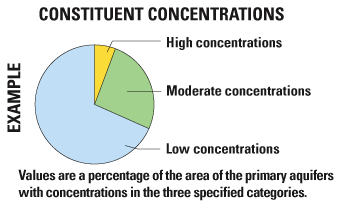 GAMA’s Priority Basin Project uses benchmarks established for drinking water to provide context for evaluating the quality of untreated groundwater. After withdrawal, groundwater may be disinfected, filtered, mixed, and exposed to the atmosphere before being delivered to consumers. Federal and California regulatory benchmarks for protecting human health (Maximum Contaminant Level, MCL) are used for the evaluation when available. Otherwise, non-regulatory benchmarks for protecting aesthetic properties (Secondary Maximum Contaminant Level, SMCL) such as taste and odor, and non-regulatory benchmarks for protecting human health (Notification Level, NL, and Lifetime Health Advisory, HAL), are used. High, moderate, and low concentrations are defined relative to benchmarksConcentrations are considered high if they are greater than a benchmark. For inorganic constituents, concentrations are moderate if they are greater than one-half of a benchmark. For organic and special-interest constituents, concentrations are moderate if they are greater than one-tenth of a benchmark; this lower threshold was used because organic constituents generally are less prevalent and have smaller concentrations relative to benchmarks than inorganic constituents. Low includes nondetections and values less than moderate concentrations. Methods for evaluating water quality are discussed in Bennett and others (2010). Factors that Affect Groundwater QualityIn the NSJ study unit, arsenic is the constituent that is most frequently (about 9%) detected at high concentrations in the primary aquifers. The primary source of arsenic in the NSJ study unit is minerals eroded from the volcanic and granitic rocks of the Sierra Nevada to the east. The human-health regulatory benchmark for arsenic is 10 micrograms per liter (µg/L). In the NSJ study unit, nearly all samples with high arsenic concentrations were collected from wells in the southwestern part of the Eastern San Joaquin study area near the margin of the Sacramento-San Joaquin Delta or in the delta. Geochemical conditions in and near the delta are conducive to arsenic dissolution. 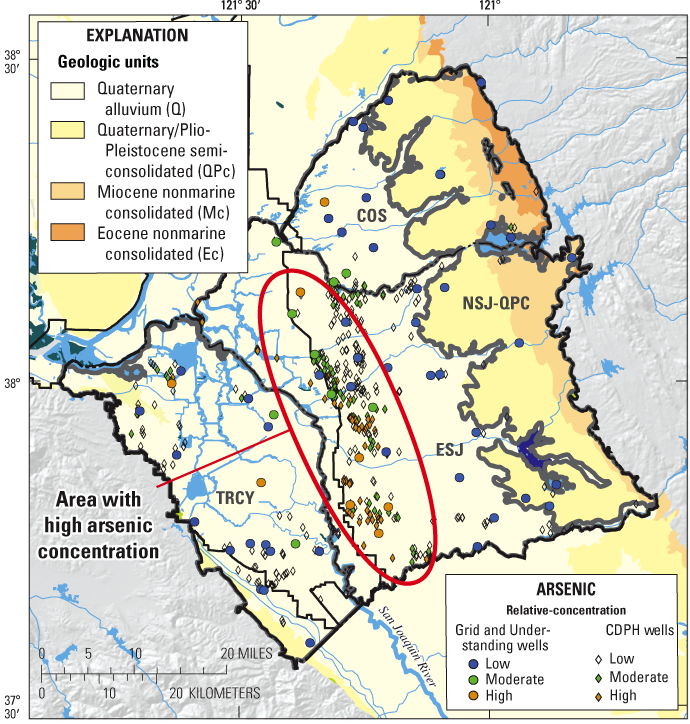
An investigation of the sources of arsenic in the eastern San Joaquin Valley by Izbicki and others (2008) also showed this pattern of high arsenic concentrations along the margin of the Sacramento-San Joaquin Delta. They attributed elevated arsenic in groundwater to reductive dissolution of iron or manganese oxy-hydroxides under iron- or manganese-reducing conditions. Although less common, dissolved arsenic also can increase from pH-dependent desorption of arsenic from aquifer sediments under oxic conditions, which tends to occur in groundwater with pH greater than 7.5 (Izbicki, 2008). In the NSJ study unit, groundwater generally flows from the margins towards the center of the basin. Oxic conditions generally do not persist and as groundwater moves through the system from the margins of the study unit—the available oxygen is slowly depleted. Groundwater within and along the margin of the Delta generally is anoxic, thus providing conditions for the dissolution of arsenic into groundwater. Priority Basin AssessmentsGAMA’s Priority Basin Project (PBP) assesses water quality in that part of the aquifer system used for drinking water, primarily public supply. Water quality in shallow and deep parts may differ from water quality in these primary aquifers. GAMA’s Domestic Well Project assesses water quality in the shallow parts of the aquifer system. Ongoing assessments are being conducted in more than 120 basins throughout California. The PBP assessments are based on a comparison of constituent concentrations in untreated groundwater with benchmarks established for the protection of human health and for aesthetic concerns. The PBP does not evaluate the quality of drinking water delivered to consumers. The PBP uses two scientific approaches for assessing groundwater quality. The first approach uses a network of wells to statistically assess the status of groundwater quality areally. The second approach combines water-quality, hydrologic, geographic, and other data to help assess the factors that affect water quality. In the NSJ study unit, data were collected by the PBP in 2004–05, and from the CDPH database for 2001–04. The PBP includes chemical analyses generally not available as part of regulatory compliance monitoring, including measurements at concentrations much lower than human-health benchmarks, and measurement of constituents that can be used to trace the sources and movement of groundwater. SELECTED REFERENCESBennett, G.L., V, Belitz, Kenneth., and Milby Dawson, B.J., 2006, California GAMA Program—Ground-water quality data in the Northern San Joaquin Basin study unit, 2005: U.S. Geological Survey Data Series 196, 122 p. (Also available at https://pubs.usgs.gov/ds/2006/196/) Bennett, G.L., V, Fram, M.S., Belitz, Kenneth, and Jurgens, B.C., 2010, Status and understanding of groundwater quality in the Northern San Joaquin Basin, 2005: California GAMA Program Priority Basin Project: U.S. Geological Survey Scientific Investigations Report 2010-5175, 82 p. (Also available at https://pubs.usgs.gov/sir/2010/5175.) California Department of Water Resources, 2003, California’s groundwater update 2003: Sacramento, California, California Department of Water Resources Bulletin 118, 246 p., accessed August 23, 2010, at http://www.water.ca.gov/groundwater/bulletin118/bulletin118update2003.cfm. Izbicki, J.A., Stamos, C., Metzger, L.F., Kulp, T., McPherson, K.R., Halford, K., and Bennett, G.L., 2008, Sources, distribution, and management of arsenic in water from wells, Eastern San Joaquin ground-water subbasin, California: U.S. Geological Survey Open-File Report 2008-1272, 8 p. (Also available at https://pubs.usgs.gov/of/2008/1272/.) Northeastern San Joaquin County Groundwater Banking Authority, 2004, Eastern San Joaquin Basin groundwater management plan: Northeastern San Joaquin Groundwater Banking Authority, Stockton, Calif., variously paged. |
First posted September 28, 2010 For additional information: Technical reports and hydrologic data collected for the GAMA Program may be obtained from GAMA Project ChiefU.S. Geological Survey California Water Science Center 4165 Spruance Road, Suite 200 San Diego, CA 92101 Telephone number: (619) 225-6100 WEB: http://ca.water.usgs.gov/gama GAMA Program Unit Part or all of this report is presented in Portable Document Format (PDF); the latest version of Adobe Reader or similar software is required to view it. Download the latest version of Adobe Reader, free of charge. |
Bennett V, G.L., and Belitz, K., 2010, Groundwater quality in the Northern San Joaquin Valley, California: U.S. Geological Survey Fact Sheet 2010-3079, 4 p.